
Monkey Island is a series of adventure games. The first four games were produced and published by LucasArts, earlier known as Lucasfilm Games. The fifth was developed by Telltale Games with LucasArts, while the sixth was developed by Terrible Toybox with Lucasfilm Games and Devolver Digital.

The Black Pirate is a 1926 American silent action adventure film shot entirely in two-color Technicolor about an adventurer and a "company" of pirates. Directed by Albert Parker, it stars Douglas Fairbanks, Donald Crisp, Sam De Grasse, and Billie Dove. In 1993, The Black Pirate was included in the annual selection of 25 motion pictures to be added to the National Film Registry of the Library of Congress, being deemed "culturally, historically, or aesthetically significant."
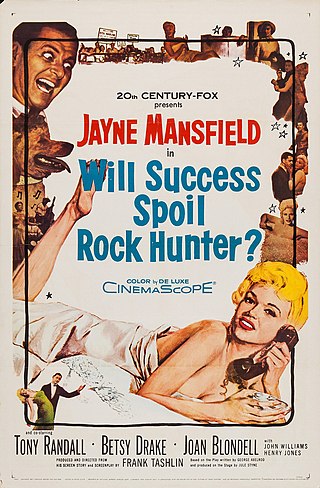
Will Success Spoil Rock Hunter? is a 1957 American satirical comedy film starring Jayne Mansfield and Tony Randall, with Betsy Drake, Joan Blondell, John Williams, Henry Jones, Lili Gentle, and Mickey Hargitay, and with a cameo by Groucho Marx. The film is a satire on popular fan culture, Hollywood hype, and the advertising industry, which was profiting from commercials on the relatively new medium of television. It also takes aim at the reduction television caused to the size of movie theater audiences in the 1950s. The film was known as Oh! For a Man! in the United Kingdom.

Loom is a 1990 fantasy-themed graphic adventure game by Lucasfilm Games. The project was led by Brian Moriarty, a former Infocom employee and author of classic text adventures Wishbringer (1985), Trinity (1986), and Beyond Zork (1987). It was the fourth game to use the SCUMM adventure game engine, and the first of those to avoid the verb–object interface introduced in Maniac Mansion.
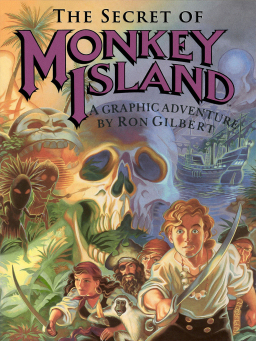
The Secret of Monkey Island is a 1990 point-and-click graphic adventure game developed and published by Lucasfilm Games. It takes place in a fictional version of the Caribbean during the age of piracy. The player assumes the role of Guybrush Threepwood, a young man who dreams of becoming a pirate, and explores fictional islands while solving puzzles.
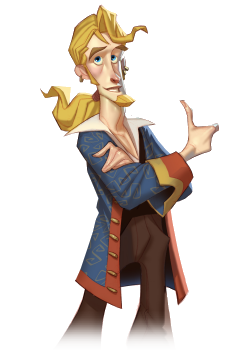
Guybrush Ulysses Threepwood is a fictional character who serves as the main protagonist of the Monkey Island series of computer adventure games by LucasArts. Guybrush is voiced by actor Dominic Armato in the third, fourth, fifth, and sixth games, as well as the enhanced remakes of The Secret of Monkey Island and Monkey Island 2: LeChuck's Revenge. Though a "mighty pirate" by his own account, he is a rather clumsy and disorganized protagonist throughout the series. It is a running joke throughout the games for characters to garble Guybrush Threepwood's unusual name, either deliberately or accidentally.

Pirates of the Caribbean: The Curse of the Black Pearl is a 2003 American fantasy supernatural swashbuckler film directed by Gore Verbinski. Produced by Jerry Bruckheimer and distributed by Walt Disney Pictures, the film is based on Walt Disney's Pirates of the Caribbean attraction at Disney theme parks and is the first film in the Pirates of the Caribbean film series. The film stars Johnny Depp, Geoffrey Rush, Orlando Bloom, and Keira Knightley. The story follows pirate Captain Jack Sparrow (Depp) and blacksmith Will Turner (Bloom) as they rescue the kidnapped Elizabeth Swann (Knightley) from the crew of the Black Pearl, captained by Hector Barbossa (Rush). Barbossa's crew attempts to retrieve the final pieces of a hoard of Aztec gold to break the curse laid on them when they stole it.

Escape from Monkey Island is an adventure game developed and released by LucasArts in 2000. It is the fourth game in the Monkey Island series, and the sequel to the 1997 videogame The Curse of Monkey Island. It is the first game in the series to use 3D graphics and the second game to use the GrimE engine, which was upgraded from its first use in Grim Fandango.

Captain Hector Barbossa is a fictional character of the Pirates of the Caribbean franchise, appearing in all five films in the series. Starting out as a villainous undead pirate in The Curse of the Black Pearl (2003), the character dies at the end of the film. However, he is revealed to have been brought back to life at the end of Dead Man's Chest before appearing in anti-heroic roles as a Pirate Lord in At World's End (2007), a privateer with the Royal Navy in On Stranger Tides (2011), and finally as the rich and influential leader of his own pirate fleet in Dead Men Tell No Tales (2017). Throughout the series, the character has been conceptualized as a "dark trickster" and the evil counterpart of Captain Jack Sparrow.
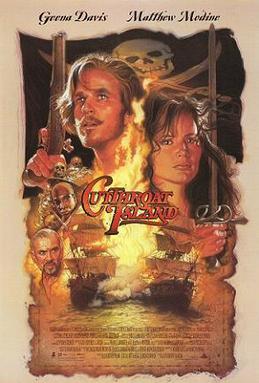
Cutthroat Island is a 1995 adventure swashbuckler film directed by Renny Harlin and written by Robert King and Marc Norman from a story by Michael Frost Beckner, James Gorman, Bruce A. Evans and Raynold Gideon. It stars Geena Davis, Matthew Modine and Frank Langella. It is a co-production between the United States, France, Germany and Italy.

Runaway: A Road Adventure is a 2001 graphic adventure game developed by the Spanish company Pendulo Studios and published by Dinamic Multimedia. It follows the story of Brian Basco, an American college student on the run after he unwittingly saves a murder witness named Gina Timmins from assassination by the New York Mafia. Searching for clues about a mysterious crucifix linked to the murder, Brian and Gina embark on a cross-country journey through the United States while pursued by two Mafia hitmen. The player assumes the role of Brian and explores the game world while collecting items, solving puzzles and conversing with non-player characters.
Pirates of the Caribbean is a Disney media franchise encompassing numerous theme park rides, a series of films, and spin-off novels, as well as a number of related video games and other media publications. The franchise originated with Walt Disney's theme park ride of the same name, which opened at Disneyland in 1967 and was one of the last Disneyland attractions overseen by Walt Disney. Disney based the ride on pirate legends, folklore and novels, such as those by Italian writer Emilio Salgari.
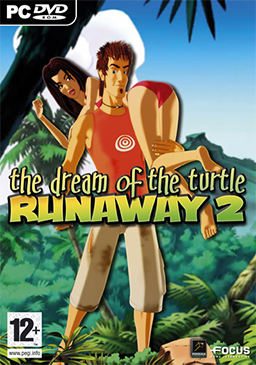
Runaway 2: The Dream of the Turtle is a 2006 graphic adventure game developed by the Spanish company Pendulo Studios and published by Focus Home Interactive. The sequel to Runaway: A Road Adventure, it follows protagonists Brian Basco and Gina Timmins as their vacation in Hawaii goes awry, sweeping up the two of them into a secret project by the United States military. The player controls Brian and explores the game world while collecting items, solving puzzles and interacting with non-player characters.
Pirates of the Caribbean is an American fantasy supernatural swashbuckler film series produced by Jerry Bruckheimer and based on Walt Disney's theme park attraction of the same name. The film series serves as a major component of the eponymous media franchise. The film plots are based on a fictionalized version of the Golden Age of Piracy, and are set primarily in the Caribbean.

Dead Reefs is a game, developed by Canadian studio Streko-Graphics and published by The Adventure Company.

The Sims Medieval is a life simulation video game that was released in March 2011 by Electronic Arts for Microsoft Windows and Mac OS X, and on September 22, 2011 for iOS, as part of The Sims series. It was also made available for Windows Phone on March 26, 2013. Set in medieval times, it allows the player to build a kingdom through quest-driven gameplay. During presentation at E3 2010, a pre-order exclusive Limited Edition was also available.

Steve Ince is a British writer and game designer, known for his work on Revolution Software titles such as the Broken Sword series, and is working on a freelance basis.
Wizarbox was a video game developer based in Sèvres, France, southwest of Paris. They are notable for their graphic adventure games developed by industry veterans, such as the So Blonde series by Steve Ince and Gray Matter by Jane Jensen . The company declared bankruptcy in December 2012 and was placed in receivership by a French court. Interaction-Games later acquired Wizarbox.

So Blonde: Back to the Island is a point-and-click adventure game released for the Wii and Nintendo DS in 2010. It is not a sequel or spin-off, but a darker "what if?" scenario based on the 2008 PC game So Blonde, which also precedes Captain Morgane and the Golden Turtle, which was released in 2012.

Captain Morgane and the Golden Turtle is a point-and-click adventure game released for Windows, PlayStation 3, Wii and Nintendo DS in 2012. It is a prequel to the 2008 game So Blonde and the 2010 game So Blonde: Back to the Island and takes place a little while before them.















